Car body style
Car body styles are variable.
Current styles
- Buggy
- Lightweight off-road vehicle with sparse bodywork.
- Convertible / cabriolet
- Has a retractable or removeable roof. A convertible allows an open-air driving experience, with the ability to provide a roof when required. Most convertible roofs are either a folding textile soft-top or a retractable metal roof. Convertibles with a metal roof are sometimes called 'retractable hardtop', 'coupé convertible' or 'coupé cabriolet'.
- Coupé
- Has a sloping rear roofline and generally two doors (although several four-door cars have also been marketed as coupés). Coupés are generally considered more sporty than their sedan counterparts.
- In US used in the funeral industry to carry flowers for burial services. Typically a coupe-style, forward-passenger compartment with an open well in the rear.[1]
- Hatchback / Liftback
- Car with a hatch-type rear door that is hinged at the roof and opens upwards. The term "hatchback" can also refer to that type of rear door, which is also used on several sports cars, SUVs and large luxury cars.[2]
- Hearse / funeral coach
- The modification of a passenger car to provide a long cargo area for carrying a coffin or casket. Hearses often have large glass panels for viewing the coffin.
- Kombi
- An abbreviation of the German word "Kombinationswagen" (combination car), the German name for station wagon or van. However, in some countries, Kombi is used to refer to a Volkswagen Type 2 (Microbus).
- Limousine
- A luxury vehicle driven by a chauffeur with a partition between the driver's compartment and the passenger's compartment. In German, the term simply means a sedan.
The smallest size of minivan/MPV.
- Minivan / multi-purpose vehicle (MPV) / people carrier / people mover
- Vehicle designed to transport passengers in the rear seating row(s) with reconfigurable seats in two or three rows. Typically has a combined passenger and cargo area, a high roof, a flat floor, a sliding door for rear passengers and high H-point seating. In Europe, some small minivans have been marketed as 'leisure activity vehicles'.
- Panel van / car-derived van / sedan delivery
- A cargo vehicle based upon passenger car chassis, and typically has one row of seats with no side windows at the rear. Panel vans are smaller than panel trucks and cargo vans, both of which are built on a truck chassis.
- A pickup truck that has a fully enclosed truck topper in its back, giving it a van-like appearance.
- Pickup truck / pickup
- A light-duty, open-bed truck. In South Africa, a pickup truck is called a "bakkie".[3]
- Roadster
- An open two-seat car with emphasis on sporting appearance or character. Initially an American term for a two-seat car with no weather protection, usage has spread internationally and has evolved to include two-seat convertibles.
- Sedan / saloon
- A fixed-roof car in a three-box design with separate compartments for engine, passenger, and cargo. Sedans can have 2 or 4-doors. A sedan is called a "berlina" in Spanish and Italian, or a "berline" in French.
- Shooting-brake
- Initially a vehicle used to carry shooting parties with their equipment and game; later used to describe custom-built wagons by high-end coachbuilders, subsequently synonymous with station wagon / estate car; and in contemporary usage a three or five-door wagons combining features of a station wagon and a coupé.
- Station wagon / estate car
- Has a two-box design, a large cargo area and a rear tailgate that is hinged to open for access to the cargo area. The body style is similar to a hatchback car, however station wagons are longer and are more likely to have the roofline extended to the rear of the car[2] (resulting in a vertical rear surface to the car) to maximize the cargo space. In French, a station wagon is called a "break".
- Examples of station wagons:
- Targa top
- A semi-convertible style used on some sports cars, featuring a fully removable hard top roof panel which leaves the A and B pillars in place on the car body.
- Ute / coupe utility
- Based on a passenger sedan chassis and has a cargo tray in the rear integrated with the passenger body (as opposed to a pickup truck, which has a separate cargo tray). In Australia, the term "ute" was originally used solely for coupe utility cars, however in recent years it has also been used for pickup trucks.
Historic styles
- Baquet
- Has two rows of raised seats, similar to horse-dawn carriages; usually did not have front doors, a roof or a windshield. The baquet ("bath tub") style was produced in the early 1900s in Europe.[4]
Also a marketing term used on cars built in the United States in the 1920s and 1930s.
- Barchetta
- Italian two-seat sports car with either an open top or convertible roof. The term was originally used for lightweight open-top racing cars of the late 1940s through the 1950s. Since the 1950s, the name barchetta ("little boat" in Italian) has been revived on several occasions, mostly for cars with convertible roofs that are not specifically intended for racing.
- Berlinetta
- Italian sports coupé, typically with two seats but also including 2+2 cars. The original meaning for berlinetta in Italian is “little saloon”.
- Cabrio coach
- A retractable textile roof, similar to a convertible/cabriolet. The difference is that where a convertible often has the B-pillar, C-pillar and other bodywork removed, the cabrio-coach retains all bodywork to the top of the door frames and just replaces the roof skin with a retractable fabric panel.
- Coupé de ville / Sedanca de ville / town car
- An external or open-topped driver's position and an enclosed compartment for passengers. Produced from 1908 to 1939. Although the different terms may have once had specific meanings for certain car manufacturers or countries, the terms are often used interchangeably.
Some coupé de villes have the passengers separated from the driver in a fully enclosed compartment, while others have a canopy for the passengers and no partition between the driver and the passengers (therefore passengers enter the compartment via driver's area).
- Hardtop
- Any car with a rigid roof. However, the term is usually used for pillarless hardtops, which are cars without a B-pillar that are often styled to give the appearance of a convertible. Popular in the United States in the 1950s and 1960s.
- Landaulet
- A car where the rear passengers are covered by a convertible top. Often the driver is separated from the rear passengers with a partition, as per a limousine.
- Personal luxury car
- American luxury coupés and convertibles produced from 1952 to 2007. The cars prioritised comfort, styling and a high level of interior features.
- Phaeton
- An open-roof automobile without any fixed weather protection, which was popular from the 1900s until the 1930s.
See also
| Wikimedia Commons has media related to Automobile body styles. |
References
- "Flower Cars: A Glance At A Forgotten Funeral Vehicle". Luxury Coach & Transportation Magazine. 1 January 1990. Retrieved 13 December 2018.
- Hillier, Victor; Coombes, Peter (2004). Hillier's Fundamentals of Motor Vehicle Technology: Volume 1 (5th ed.). Nelson Thornes. p. 11. ISBN 978-0-7487-8082-2. Retrieved 15 January 2013.
The estate body, also known as station wagons in some countries, has the roofline extended to the rear of the body to enlarge its internal capacity. Folding the rear seats down gives a large floor area for the carriage of luggage or goods. Stronger suspension springs are fitted at the rear to support the extra load. Hatchback: Although some hatchbacks are in fact saloon bodies with the boot or trunk effectively removed (usually the smaller cars) many hatchbacks retain the full length of the saloon, but the roofline extends down to the end of the vehicle...as with the estate, the rear seats fold down to give a flat floor for the transportation of luggage or other objects. When the tailgate is closed, the luggage compartment is usually covered with a parcel shelf.
- "Bakkie: definition". Oxforddictionaries.com. Retrieved 12 August 2014.
- "Body Styles". aaca.org. Archived from the original on 22 March 2019. Retrieved 24 April 2019.
This article is issued from Wikipedia. The text is licensed under Creative Commons - Attribution - Sharealike. Additional terms may apply for the media files.
_Roadster_GT_convertible_(2018-10-30)_01.jpg.webp)
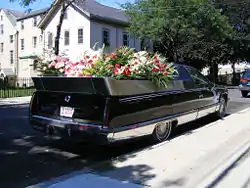
_%E2%80%93_Heckansicht%252C_17._M%C3%A4rz_2013%252C_Ratingen.jpg.webp)
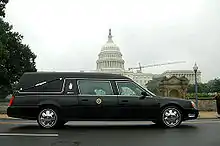
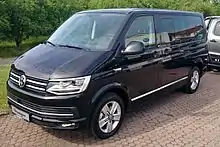



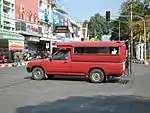
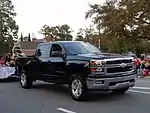

_Ascent_sedan_(2018-08-27)_01.jpg.webp)
_(cropped).jpg.webp)
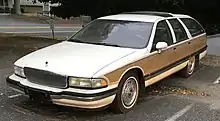
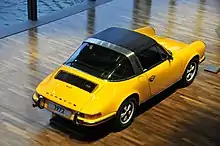
_SV6_utility_(2018-10-01)_01.jpg.webp)